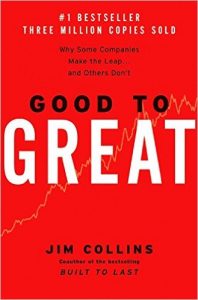 Jim Collins’ book Good to Great is another excellent business book that discusses concepts from large business points of view. As I have noted before, I am interested in how these large company concepts can be applied to your small business to help you survive, grow and meet your goals. There were many great points in the book and here are a few that I thought most relevant to the small business owner.
Jim Collins’ book Good to Great is another excellent business book that discusses concepts from large business points of view. As I have noted before, I am interested in how these large company concepts can be applied to your small business to help you survive, grow and meet your goals. There were many great points in the book and here are a few that I thought most relevant to the small business owner.
Confront the Brutal Facts
This is especially difficult when the brutal facts do not paint a rosy picture. We tend to be wishful that issues like a decline in business or problem employees will be fixed on their own. I encourage you to solicit honesty from your employees and customers. Be honest with yourself about the financial condition and direction of your company. Take a realistic look at your industry and competitors. Don’t lie to yourself and accept the “do nothing” option.
The book mentioned the Stockdale Paradox. It basically says to retain faith that there will eventually be a good result, but face the brutal fact the journey may be difficult and require effort.
The Right People
The book mentioned “get the right people on the bus and the wrong people off the bus”. Also, “letting the wrong people hang around is unfair to the right people”.
For small businesses, “people” includes not only employees, but also vendors, service providers and even customers. It is more difficult for a five employee business to absorb the effects of a problem, low performing employee than it is for a five hundred employee business to absorb the effects. That one employee represents 20% of the workforce for the small business.
Believe it or not, you may need to get a customer off the bus. If you have a customer that is extremely demanding, offers low margins, is slow paying and requires a great deal more effort to satisfy than your other customers, you may want to consider getting that customer off the bus.
Business Transformation Takes Time
In the book, the research revealed that there was no singular event that led to positive transformation. “It was a whole bunch of interlocking pieces that built one upon another”. Sam Walton, founder of Wal Mart, built his first store in 1945 and the second in 1952. It took him twenty-five years to get to 38 stores.
Yes, confront the brutal facts, get the right people on the bus and take other positive actions, but also be patient.
Let us know how we can be helpful to you. Contact us today!

